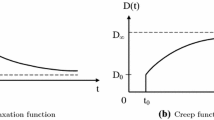Abstract
The problem of optimal selective mass scaling for linearized elasto-dynamics is discussed. Optimal selective mass scaling should provide solutions for dynamical problems that are close to the ones obtained with a lumped mass matrix, but at much smaller computational costs. It should be equally applicable to all structurally relevant load cases. The three main optimality criteria, namely eigenmode preservation, small number of non-zero entries and good conditioning of the mass matrix are explicitly formulated in the article. An example of optimal mass scaling which relies on redistribution of mass on a global system level is constructed. Alternative local mass scaling strategies are proposed and compared with existing methods using one modal and two transient numerical examples.












Similar content being viewed by others
Notes
Independently published and analyzed for linear and non-linear problems in [10].
The Jacobi preconditioner contains on the diagonal the inverted values of \({\mathbf {{P}}}_{\mathrm {J},ii } = ({\mathbf {{M}}}_{ii})^{-1}\).
References
Allemang RJ (2003) The modal assurance criterion—twenty years of use and abuse. Sound Vib 37(8):14–23
Askes H, Nguyen D, Tyas A (2011) Increasing the critical time step: micro-inertia, inertia penalties and mass scaling. Comput Mech 47:657–667. doi:10.1007/s00466-010-0568-z
Cocchetti G, Pagani M, Perego U (2012) Selective mass scaling and critical time-step estimate for explicit dynamics analyses with solid-shell elements. Comput Struct 127:39–52. doi:10.1016/j.compstruc.2012.10.021
Eck C, Kovalenko Y, Mangold O, Prohl R, Tkachuk A, Trickov V (2014) Reduction of numerical sensitivities in crash simulations on HPC-computers (HPC-10). In: Nagel WE, Kröner DH, Resch MM (eds) High performance computing in science and engineering ’13. Springer, Berlin, pp 679–697. doi:10.1007/978-3-319-02165-2_48
Engblom J, Chang C (1991) Nonlinear dynamical response of impulsively loaded structures—a reduced basis approach. AIAA Journal 29(4):613–618. doi:10.2514/3.10629
Gantmacher F (1959) The theory of matrices. Chelsea, New York
Gavoille S (2013) Enrichissement modal du selective mass scaling (in French). In Proceedings of 11e Colloque National en Calcul des Structures by Calcul des Structures et Modélisation (CSMA 2013)
Hughes T, Hilber H, Taylor R (1976) A reduction scheme for problems of structural dynamics. Int J Solids Struct 12(11):749–767. doi:10.1016/0020-7683(76)90040-8
Lawther R (2005) On the straightness of eigenvalue interactions. Comput Mech. doi:10.1007/s00466-005-0675-4
Macek RW, Aubert BH (1995) A mass penalty technique to control the critical time increment in explicit dynamic finite element analyses. Earthq Eng Struct Dyn 24(10):1315–1331. doi:10.1002/eqe.4290241003
Naumov M (2011) On the modification of an eigenvalue problem that preserves an eigenspace. J Comput Appl Math 235(18):5432–5440. doi:10.1016/j.cam.2011.06.003
Olovsson L, Simonsson K (2006) Iterative solution technique in selective mass scaling. Comm Num Methods Eng 22(1):77–82. doi:10.1002/cnm.806
Olovsson L, Simonsson K, Unosson M (2005) Selective mass scaling for explicit finite element analyses. Int J Numer Methods Eng 63(10):1436–1445. doi:10.1002/nme.1293
Olovsson L, Unosson M, Simonsson K (2004) Selective mass scaling for thin walled structures modeled with tri-linear solid elements. Comput Mech 34:134–136. doi:10.1007/s00466-004-0560-6
Simo JC, Armero F (1992) Geometrically non-linear enhanced strain mixed methods and the method of incompatible modes. Int J Numer Methods Eng 33(7):1413–1449. doi:10.1002/nme.1620330705
Simo JC, Rifai M (1990) A class of mixed assumed strain methods and the method of incompatible modes. Int J Numer Methods Eng 29(8):1595–1638. doi:10.1002/nme.1620290802
Tkachuk A, Bischoff M (2013) Variational methods for selective mass scaling. Comput Mech 52:563–570. doi:10.1007/s00466-013-0832-0
Tkachuk A, Wohlmuth B, Bischoff M Hybrid-mixed discretization of elasto-dynamic contact problems using consistent singular mass matrices. Int J Numer Meth Eng 94:473–493. doi:10.1002/nme.4457
Washizu K (1975) Variational methods in elasticity and placticity, 2nd edn. Pergamon Press, Oxford
Zienkiewicz O, Taylor R (2006) The finite element method, 6th edn. Elsevier Science, Amsterdam
Acknowledgments
The authors are thankful to both reviewers for their detailed and helpful comments which significantly improved the manuscript. Moreover, the helpful discussions with our graduate student Baris Cansiz in the primary stage of this work are gratefully acknowledged.
Author information
Authors and Affiliations
Corresponding author
Additional information
Support of Baden-Württemberg Stiftung gGmbH Grant HPC-10 is gratefully acknowledged.
Rights and permissions
About this article
Cite this article
Tkachuk, A., Bischoff, M. Local and global strategies for optimal selective mass scaling. Comput Mech 53, 1197–1207 (2014). https://doi.org/10.1007/s00466-013-0961-5
Received:
Accepted:
Published:
Issue Date:
DOI: https://doi.org/10.1007/s00466-013-0961-5




